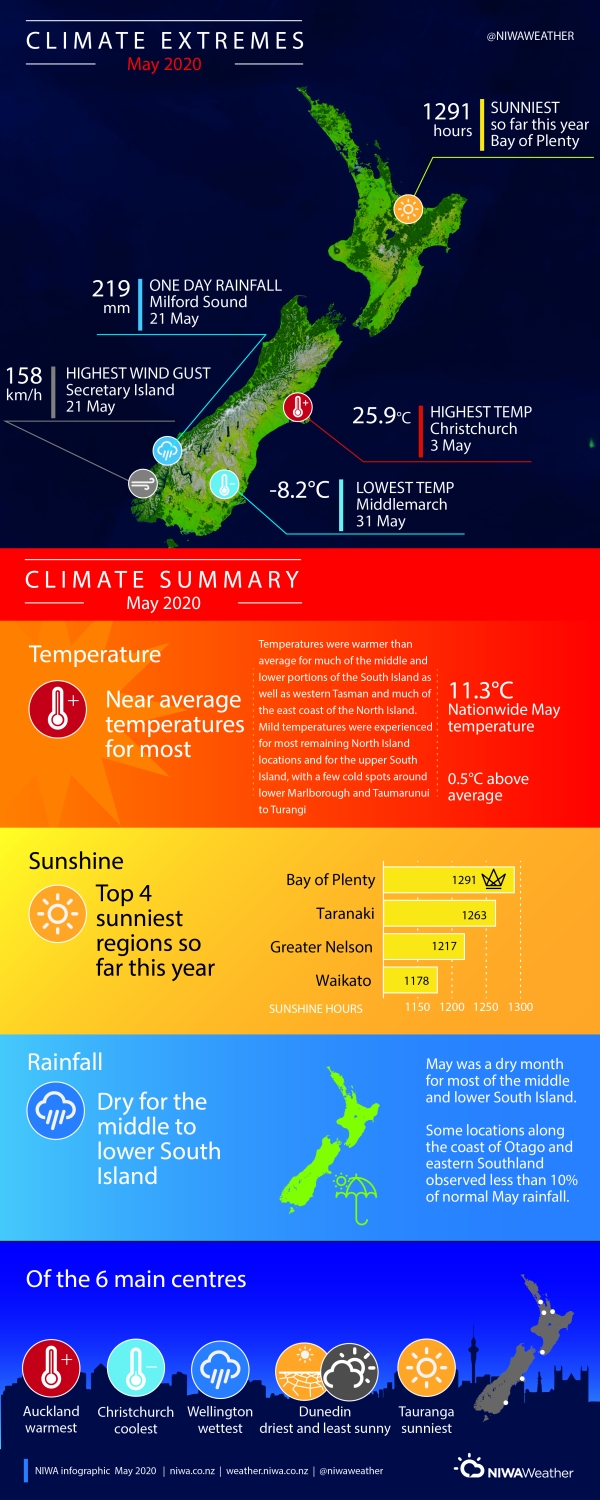Warm and dry for the middle to lower South Island
|
Rainfall |
For locations in the middle and lower South Island, rainfall was below normal (50-79% of normal) or well below normal (<50% of normal) with increasing dryness toward the east of these areas. The upper South Island observed above normal (120-149% of normal) or well above normal (>149% of normal) rainfall in Hurunui, Tasman and northern Marlborough, and near normal rainfall (80-119% of normal) in remaining locations. In the North Island, rainfall was below normal for many locations between upper Waikato and lower Manawatu-Whanganui, although near normal rainfall was observed in some locations between Taranaki and Te Urewera. Most locations in the Auckland and Wellington regions experienced near or above normal May rainfall, while rainfall in Northland was below normal to the west and above normal to the east. |
|
Soil Moisture |
At the end of May, soils were drier than normal for many northern, central and eastern parts of the North Island, as well as eastern, inland and southern parts of the South Island. Soil moisture was generally near normal for remaining parts of the country. |
|
Temperature |
Temperatures were above average (0.51-1.20°C above average) or well above average (>1.20°C above average) for many locations in the middle and lower South Island as well as the western parts of the Tasman District. Above average temperatures were also experienced along the eastern margins of the North Island and around Hunterville in the Manawatu-Whanganui region. Remaining parts of both islands largely experienced near average (±0.50°C of average) temperatures except for isolated areas around lower Marlborough and between Taumarunui and Turangi where temperatures were below average (0.51-1.20°C below average). |
Overview
May 2020 mean sea level air pressure was above normal over and to the east of New Zealand and lower than normal to the southwest of the country. This was associated with more easterly and northeasterly air flows than normal. Dry conditions were widespread for the middle and lower portions of the South Island. Eastern parts of this area observed the lowest rainfall amounts with respect to normal for May and several locations there set new record low rainfall totals for the time of year. May was also relatively dry for a good portion of the North Island, particularly for many locations between the upper Waikato and lower Manawatu-Whanganui regions as well as for western Northland. Some notable rainfall events occurred during the month, leading to elevated rainfall totals for eastern Northland, western Auckland, western Wellington, Nelson, northern Marlborough and Hurunui. Coromandel Peninsula was hard hit by a storm at the very end of the month (extending into the start of June) and the May rainfall total at Whitianga was 208% of normal (2nd-highest on record for May). Impacts of this storm are listed in the Highlights and extreme events section.
Temperatures were above average (0.51-1.20°C above average) or well above average (>1.20°C above average) throughout the middle to lower portion of the South Island as well as western parts of the Tasman District and much of the east coast of the North Island. Mild temperatures were experienced however for much of the remaining North Island locations and for the upper South Island, with a few cold spots around lower Marlborough and Taumarunui to Turangi. Overall, the nationwide average temperature in May 2020 was 11.3°C. This was 0.5°C above the 1981-2010 May average from NIWA’s seven station temperature series which begins in 1909.
Further Highlights:
- The highest temperature was 25.9°C, observed at Christchurch on 3 May.
- The lowest temperature was -8.2°C, observed at Middlemarch on 31 May.
- The highest 1-day rainfall was 219 mm, recorded at Milford Sound on 21 May.
- The highest wind gust was 158 km/h, observed at Secretary Island on 21 May.
- Of the six main centres in May 2020, Auckland was the warmest, Christchurch was the coldest, Wellington was the wettest, Dunedin was the driest (by a good margin) and least sunny, and Tauranga was the sunniest.
- Of the available, regularly reporting sunshine observation sites, the sunniest four locations in 2020 so far are Bay of Plenty (1291 hours), Taranaki (1263 hours), Greater Nelson (1217 hours) and Waikato (1178 hours).


